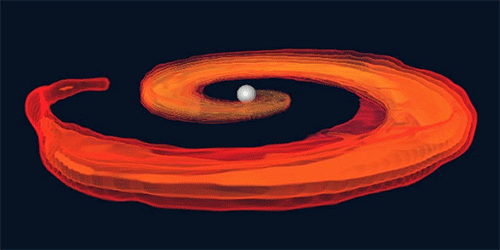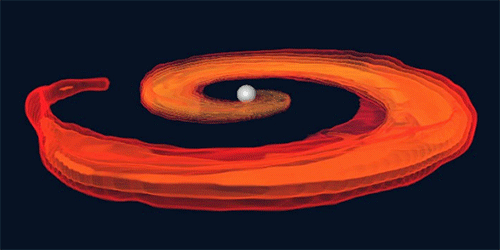Ideal Mergers for Measuring Cosmic Expansion
Gravitational-wave astronomy is budding with possibilities, such as the use of gravitational-wave sources as distance markers for measuring cosmic expansion. A new report from Salvatore Vitale from the Massachusetts Institute of Technology, Cambridge, and Hsin-Yu Chen from Harvard University shows that a specific kind of gravitational-wave source—involving the merger of a black hole with a neutron star—could be the best target for determining the expansion rate.
The current expansion rate, or Hubble constant, is a crucial factor in cosmological calculations, so its uncertainty limits how well we know other parameters, like the age of the Universe. But some measurements of the Hubble constant using the cosmic microwave background give different results than those based on supernova observations (see 20 April 2018 Feature), so researchers would like a third, independent method to resolve the tension.
Mergers of compact objects can be used to measure the Hubble constant. This is most easily done when the event is observed in two ways: with gravitational waves (to gauge the distance to the source) and with electromagnetic waves (to determine the source’s velocity). Such a Hubble constant measurement was already demonstrated with the observed merger of two neutron stars (see 16 October 2017 Viewpoint). But the uncertainty was fairly high (14%) because of uncertainty in the orbital orientation, which is correlated with the measured distance of the merger. Vitale and Chen show that neutron star black hole (NSBH) mergers give a more precise distance estimate than binary neutron star (BNS) mergers, mainly because the orbital orientation is less correlated with the distance measurement. No NSBH merger has yet been recorded. But if one NSBH event occurs for every 50 BNS events, which is consistent with current constraints, then future NSBH measurements will provide a more precise Hubble constant determination than BNS observations, according to Vitale and Chen.
This research is published in Physical Review Letters.
–Michael Schirber
Michael Schirber is a Corresponding Editor for Physics based in Lyon, France.





